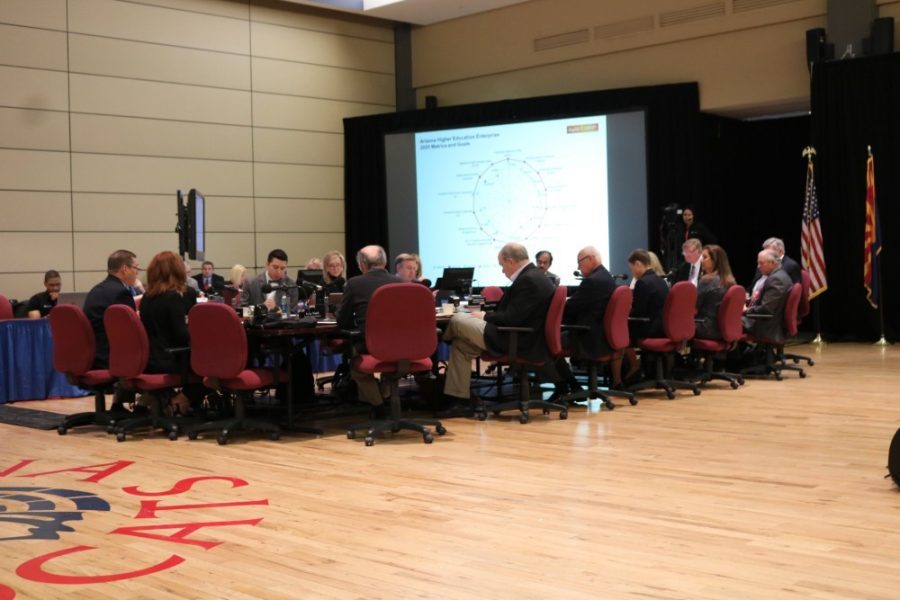The Arizona Board of Regents, the governing body of Arizona’s three public universities, approved six new development projects proposed by the University of Arizona during its meeting on campus Nov. 15.
The projects, totaling $352 million, will focus on expanding UA’s research infrastructure to draw in national research grants, provide students research opportunities and expand UA’s international reputation.
The new projects will play a major role in catapulting UA to $800 million in total research activity by 2025, a key tenet of UA’s Strategic Plan presented to the regents this week by UA President Dr. Robert Robbins.
RELATED: Regents vote to change tuition-and-fee setting process
The infrastructure will focus on positioning UA as a leader in the “Fourth Industrial Revolution” by fostering interdisciplinary, cutting-edge research and preparing students for the jobs of the future, according to Robbins.
Applied Research Building
The UA hopes to begin construction of the Applied Research Building that will be located adjacent to the Aerospace and Mechanical Engineering building in the summer of 2020. The projected $50 million cost will be funded through university debt.
Once complete in the fall of 2021, ARB will be home to interdisciplinary research laboratories and manufacturing centers focused on material and product design and testing. ARB will also house UA’s Applied Research Corporation and be equipped to conduct sensitive, government-funded research.
Grand Challenges Research Building
The Grand Challenges Research Building will be located between UA’s Library and the McKale Memorial Center, which houses UA’s basketball team. The ten-story research facility will cost the university $150 million, which will be financed exclusively through university debt.
After completion in 2022, GCRB will be home to engineers, physical and health scientists researching precision health, environments, space and more. By bringing faculty and students from diverse fields together, the university will strive to foster collaborations that enhance research into artificial intelligence, imaging technologies, cognitive aging and material sciences.
Campus Deferred Maintenance
In 2016, the UA had over $130 million in deferred maintenance costs. After receiving funding from the Arizona State Legislature to secure cost-effective loans, the UA plans to spend hundreds of millions of dollars improving aging campus infrastructure over the next decade.
In 2017, UA began its deferred maintenance projects by renovating its Veterinary Science and Microbiology Building.
This year, the regents approved the spending of $11 million from UA’s budget for replacements of aging mechanical, electrical and plumbing infrastructure in the Steward Observatory. An additional $10 million will be spent on similar projects around campus and be completed by the end of 2019.
Phoenix Biomedical Sciences Partnership Building
“We need to build up our Phoenix medical campus,” Robbins said.
To accomplish this goal, UA planned to refit the third and fourth floors of the Biomedical Sciences Partnership Building to house research laboratories and faculty for the College of Medicine – Phoenix.
The $34 million project, which will conclude in 2020, will also include the recruitment of 30 research faculty members by the UA College of Medicine – Phoenix.
The UA will finance the project through debt, but will help maintain the space by leasing laboratory research space to the Phoenix Veterans Affairs Medical Center, expanding its current partnership with the VA.
Student Success District
“The Student Success District will be the center point for all student services, advising, mentoring, gathering [and] activities and will serve as a place for students to gather,” Robbins said.
The SSD will include UA’s Science and Engineering Library, Main Library and Bear Down Gym along with a new Student Success Building.
The $81 million project, financed through university debt and gifts, will renovate Bear Down Gym as well as the Main and Science and Engineering Libraries, build the new Student Success Building, redesign the outdoor environment and create new linkages between SSD buildings.
The stated goal of the new district, sponsored by the Office of the Provost and UA’s Libraries, is to centralize student services and academic support as well as create a hub for students to access library technology, campus and wellness programming, tutoring and create a space for collaboration. According to Robbins, it will be unique in the nation and help reimagine what a library space can be.
“The Student Success District will be a special place – it will not only help us recruit the brightest students, but it will also be one of the center points of academic life,” Robbins said.
Campus Research Infrastructure
In order to accommodate the planned growth in campus research, the UA will spend $16 million to improve research infrastructure, funded by university debt.
The funding will help expand storm drains, data systems and other infrastructure on campus.
These new development projects will increase UA debt to over six percent of its yearly expenditures but keep it below its eight percent maximum, according to law.
Ongoing Projects
Currently, UA has eight ongoing capital development project and one private partnership, the construction of the new Honors Village, in which UA is recruiting students to live starting in fall 2020.
As of the regents’ meeting, renovations on UA’s Veterinary Science and Microbiology Building are 60 percent complete. The College of Pharmacy Skaggs Building’s renovations are 12 percent complete.
RELATED: College of Pharmacy Skaggs Pharmaceutical Sciences Center renovations approved
UA’s new $165 million Health Sciences Innovation Building, located on north campus, is 85 percent complete and will expand UA’s laboratory research on north campus.
UA has a number of sport facility improvements currently underway, with some nearing completion.
This year UA completed four capital development projects.
Follow Randall Eck on Twitter








